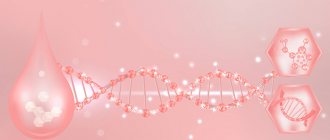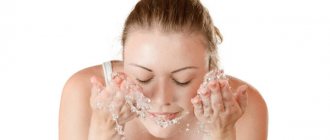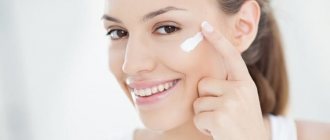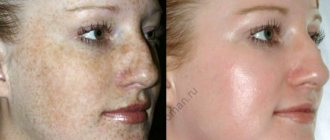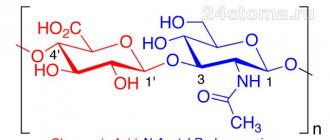Advantages and benefits of hyaluronic acid
Hyaluronate molecules have similar properties, but some of them have increased activity. There are low molecular weight, medium molecular weight and high molecular weight compounds. In cosmetology, the first type is used, since the active substance molecules have a small mass and easily penetrate into the deep layers of the skin. Low molecular weight hyaluronate is the main component of cosmetics intended for external use. As for high-molecular compounds, the molecules do not penetrate the epidermis due to their increased mass.
The widespread use of hyaluronic acid in cosmetology is due to its beneficial properties:
- normalization of the elasticity of the walls of blood vessels;
- protection of the upper layer of skin from ultraviolet radiation;
- improvement of the structural components of the skin responsible for the production of elastin and collagen;
- maintaining a normal level of moisture in the dermis;
- stimulation of skin cell renewal (regeneration);
- protection against the penetration of pathogenic microbes through the upper layers of the skin.
Since hyaluronan stimulates regeneration and cell division, its effect becomes negative if a person has a malignant tumor.
Features of children's skin
The child's sebaceous and sweat glands are formed from birth, but the first years of life work poorly. Due to their insufficient activity, the protective layer is thin and permeable to microorganisms and chemical molecules. The connection between the upper layer of the epidermis and the underlying dermis is weak, so children under 10 years of age are more likely to experience allergies and inflammation.
A study by the Johnson & Johnson Children's Science and Technology Center confirmed that a child's skin is 20-30% thinner than an adult's skin. It is looser: the cells forming the stratum corneum are less connected to each other. There is more water than fat in the composition: this makes the skin sensitive to irritants. In children of the first years of life, the ratio of weight to body surface is 1.5 times greater than in adults. Therefore, the concentration of substances in the child’s blood is higher when using the same amount of cosmetics.
During adolescence, the skin changes: the sebaceous glands work more actively, the pH shifts to the alkaline side. An oily sheen, closed and open comedones appear.
“During puberty, due to hormonal changes, the qualitative composition of sebum changes, creating a nutrient medium for microorganisms. The local immunity of the skin decreases, bacteria, viruses and fungi multiply more actively, and rashes appear more often,” says Nadezhda Nabatnikova, a dermatovenerologist and podologist at the GMS clinic.
In what cases is it necessary
Every day, hyaluronic acid molecules break down and form new compounds. With age, the processes of decomposition of the substance predominate and the content of hyaluronate in the epidermis decreases. The natural synthesis of the natural component slows down after 25 years, and in all tissues of the body. As a result, age-related changes appear: skin withering, wrinkles, dehydration.
Hyaluronic acid is a unique substance that is found only in the tissues of a living organism and is synthesized naturally. There are no analogues of this carbohydrate in nature. Cosmetics containing hyaluronate were previously produced based on animal components. In modern cosmetology, it is obtained artificially, and the substance is a copy of hyaluron synthesized by the human body.
With the help of preparations containing hyaluronic acid, you can prolong the youth of the epidermis; they are suitable for all types of skin. However, it is recommended to use them from 25 to 30 years of age.
Is it possible to use my mother's cosmetic bag?
Decorative products for adults cause allergies, redness and rashes in the child. The concentration of fragrances, preservatives and pigmenting substances in them is higher than in children's cosmetics: this is necessary for the durability of makeup. Some foundations and concealers
“Such decorative cosmetics are designed for the adaptive capabilities of fully formed skin. Adults have a thicker stratum corneum, the skin is less sensitive, and it contains enough enzymes and lipids. Adult cosmetics have slightly different tasks: they must be long-lasting, so they contain bright pigments and have a denser texture,” says Sergeeva.
Mom’s cosmetic bag also contains waterproof products based on wax, alcohol and silicone. To remove them, you have to rub your face: this traumatizes children's skin, causing irritation, dryness and microcracks.
Cosmetics and makeup brushes are a source of viruses and bacteria. Using the same mascara, eyeliner or lipstick with the mother, the child becomes infected with a staphylococcal infection, herpes or conjunctivitis.
When is hyaluronic acid effective?
The oval of the face changes its shape with age, and the skin becomes flabby. This is especially true for the area between the eyebrows and the nasolabial triangle. The corners of the lips droop, and the lips themselves become thinner. Visually, the face takes on a sad and tired appearance. These natural signs of aging are caused by a lack of hyaluronic acid in skin cells. The processes also affect collagen fibers, which are gradually destroyed.
With age, a lack of hyaluronate is observed in cartilage and intra-articular fluid. Therefore, it is important not only to take care of the skin externally, but also to nourish the body from the inside.
You can slow down the appearance of wrinkles and fine lines on the face with the help of cosmetics if they contain active hyaluronan. In addition to the external use of preparations with hyaluronic acid, there are dietary supplements and injections that “supply” the important polysaccharide inside the body.
Indications and contraindications
Cosmetologists do not recommend resorting to injection procedures or taking dietary supplements based on hyaluronic acid before 25–30 years of age. The use of some cosmetics for external use gives an effect after the first use. However, the rejuvenation effect does not last forever - serums, creams or ointments are used regularly, but intermittently.
Indications for the use of preparations with hyaluronate
- Age-related changes in the epidermis, the appearance of wrinkles, including facial wrinkles.
- Dry skin of the body and face.
- Rehabilitation period after deep skin peeling;
- The initial stage of arthrosis.
- Spinal diseases.
- Recovery period after eye surgery.
The structure and chemical composition of synthetic hyaluronan is completely identical to its natural counterpart. Despite the absence of allergic reactions of drugs containing HA, in some cases they should be used with caution.
At what age should hyaluronic acid be used?
Doctor Boris CHEREMITSYN advises:
— Hyaluronic acid is involved in most vital processes occurring in the human and animal body. The substance is formed in the human body, and about 1/3 of the total amount of hyaluronate is broken down and utilized daily, and this deficiency is replenished with new molecules.
It is a polysaccharide and consists of many identical small fragments, the number of which may vary. Therefore, the hyaluronate molecule can have different lengths and weights.
Why is acid needed?
The hyaluronate molecule is part of many tissues and fluids of the body, including the dermis:
- keeps collagen and elastin fibers in the correct position and thereby helps maintain the elasticity and turgor of the skin, being a prerequisite for preserving youth;
— by binding water, it ensures optimal moisture content in the skin, maintaining hydrobalance, which is also a factor preventing wrinkles and aging;
- reduces moisture evaporation and at the same time helps to attract and retain water from the air on the surface of the dermis, moisturizing the skin and making it smoother and more elastic;
— acid molecules prevent pathogenic microbes from penetrating deeper in the presence of damage, such as wounds, scratches, etc.
"Hyaluronka" lasts two days
The “lifetime” of a hyaluronate molecule in the epidermis and dermis is 1-2 days. The best hyaluronic acid for the face is your own, which is produced in the body. But with age, the ability to synthesize acid in the required quantity and with the proper molecular weight decreases, which also plays a role in aging. Therefore, the body needs an additional source of acid, one of which is cosmetic preparations.
Signs of hyaluronic acid deficiency
Changes on the face that gradually occur if there is a deficiency of hyaluronic acid in the body: the nasolabial triangle stands out; lips become thin; the contours of the face “blur”; the corners of the mouth droop.
Hyaluronic acid maintains the shape and contours of our body. It is responsible for hydration and volume, maintaining water balance.
When the body dries out, it looks older. Wrinkles develop faster and the skin fades. It is possible to fight these processes, but the more they progress, the more difficult it will be to restore the skin, and the less effective cosmetic procedures or taking dietary supplements will be.
Smear, drink or inject?
This substance is used in cosmetology and medicine in different ways. Here are its most common methods of use:
- application to the face in the form of cosmetics (creams, masks, gels, serums, lipsticks). The least effective method, has a short-term effect, but with long-term use it protects the skin from premature aging;
— oral administration in the form of dietary supplements (tablets, capsules);
- injection for the correction of specific cosmetic defects - the drug fills skin defects, changes the shape of the lips or corrects the contours of the face;
- mesotherapy with hyaluronic acid - injections for skin rejuvenation, elimination of wrinkles;
- intra-articular injections are used as a method of treating osteoarthritis - non-inflammatory joint damage.
From what age?
The use of hyaluronic acid depends on the form of release. Thus, when using external products (creams, masks), there are practically no age restrictions on cosmetics.
Taking supplements orally. Since most supplements are intended for adults, they can be taken from 18 years of age, unless otherwise indicated in the description of the drug.
Injection procedures should be avoided until age 25, as facial contours are still developing at a young age. Mesotherapy is used to correct wrinkles, so at a young age, if they are absent, its use is pointless. Usually it is used only at 35-40 years of age or later.
Injections of hyaluronic acid into the joint can be used from the age of 18, but in practice, osteoarthritis before the age of 28 is very rare. This is a disease of middle and old age.
It is believed that until the age of 25, the body produces a sufficient amount of hyaluronic acid. Therefore, although theoretically it can be used earlier, there is no practical sense in this. The man is already young, his skin is in excellent condition. So, if you are thinking about what age to start drinking hyaluronic acid in capsules and applying it to the skin, you can take 25 years as a reference point.
Safety of hyaluronic acid
Hyaluronic acid is a substance natural to our body that is produced by our own cells. Therefore, the range of uses of hyaluronic acid is very diverse. It can be used by both young and old people, with virtually no risk of negative health consequences.
Tips for purchasing hyaluronic acid
What you should know when purchasing hyaluronic acid in ampoules or tablets:
Beware of fakes. Buy the drug from trusted companies or online stores. Please note that the packaging must indicate the manufacturer, contact details, and importer in your country.
Don't buy at a low price. Please note that, for example, in Japan a product with collagen and hyaluronic acid costs about 3,000 yen (about 1,500 rubles). If hyaluronic acid tablets or ampoules are suspiciously cheap, refuse to purchase.
Pills and injections have different effects. The drug taken orally has a significantly less effect than mesotherapy or biorevitalization with hyaluronic acid. In the case of injections, the effect is targeted, and the pills act in combination on the entire body.
Contraindications
Preparations with hyaluronate have certain contraindications, which should definitely be taken into account when choosing this method of skin rejuvenation:
the presence of allergic reactions to components;
lactation period;
pregnancy;
diseases of the kidneys and cardiovascular system.
During the period of bearing a child and breastfeeding, clinical trials of drugs with hyaluronate have not been conducted, so it is unknown what effect they will have on the woman, fetus and child.
In any case, the best option would be to consult a cosmetologist before starting to take the drug.


